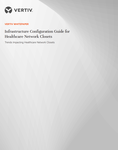When it comes to technology management, few industries are as dynamic as healthcare. Rising costs, an aging population, growth of chronic diseases and a changing regulatory environment are pushing healthcare providers to invest in new technologies to lower costs and improve patient outcomes.
While sophisticated imaging and telemedicine systems tend to get the headlines, the humble network closet is becoming increasingly important in enabling hospitals to get the most out of their technology investments.
Network closets represent a vital link in connecting people, processes, and equipment to enable digitalization. Today’s closets are also supporting a broader range of equipment, more critical applications and an expanding delivery network that can include surgery centers, urgent care facilities, imaging centers and other satellite facilities.
Evolving Infrastructure to Meet New Demands
These trends are forcing many healthcare organizations to upgrade the infrastructure within existing closets and consider more robust technologies for new closet designs. If you’re in that boat, here are four systems you should pay special attention to:
- Power continuity
You need to ensure IT equipment receives clean, conditioned power and can continue to function in the event of a utility outage. Depending on the application, this is delivered through some combination of an uninterruptible power supply (UPS), power distribution unit (PDU), circuit breakers, automatic transfer switch and backup generator. The UPS is at the heart of this system and, for closets that aren’t connected to generators, determines how long applications can run in the event of an outage. - Cooling
As the capacity of network closet equipment increases, the risk of operating in unsafe temperatures rises as well. There are multiple cooling solutions available today that are designed specifically for network closets, including rackmount and ceiling-mount systems. - Organization
The rack system that houses IT and infrastructure equipment is relatively simple, but you should consider how your rack configuration impacts airflow, physical security and cable management. - Software and services
In most cases, you’ll want the ability to monitor and manage closets locally and remotely, and this has never been easier to implement. You’ll also want to consider whether third-party services are required to support installation and maintenance. UPS batteries have a limited lifespan and the more closets you have, the more time you will spend replacing batteries.
Best practices for optimizing closet infrastructure
Whether you are designing closets for a new building or embarking on a technology refresh,
these best practices can help you optimize closet infrastructure for reliability, scalability and manageability.
- Standardize where you can.
New construction is the perfect time to consider a “standard” design that can help drive costs out and simplify ongoing operation and maintenance. Categorize designs based on size and criticality of space. Considerations should include backup power requirements to support reliability, rack sizes and types, remote monitoring capabilities and cooling options for optimizing environmental conditions. - Organize for access and security.
Most network closets have limited space. To enable efficient maintenance and troubleshooting, cable management should be used to help keep the rack area organized and clear of cluttered data, power and network cables. Proper cable support is also critical to facilitate efficient modifications, additions or changes to network systems. - Optimize for energy efficiency.
A network closet may not seem like a power hog compared to the main data center, but as the number of closets multiply and the density of each closet increases, the need for dedicated cooling will likely increase, which will increase power usage. Planning ahead to enable energy measurement through smart power distribution units can help you monitor and manage energy usage. - Enable remote monitoring and management.
Equip your closets with smart hardware, connectivity tools, software and sensors to enable visibility and control across hundreds of closets from a centralized location. Monitor power usage and fluctuations, as well as environmental conditions, including temperature and humidity, to improve uptime and efficiency while reducing operating costs. - Secure data and equipment.
In the heavily regulated healthcare environment, you can’t take risks when it comes to patient privacy protection. If closet access isn’t secure, you may need to implement rack-level security, including simple key locks, biometric locks or fobs. You may also need to control access to network cables. If networking equipment is hosted in the closet, the same access requirements that apply to your data center or server room should be applied to network closets.
Specifying and configuring infrastructure for network closets doesn’t have to be complicated, but it does require careful consideration of technology and application requirements and benefits greatly from implementation of best practices. For more information on specifying infrastructure for healthcare closets, read the Vertiv white paper, Infrastructure Configuration Guide for Healthcare Network Closets.





